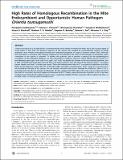Files in this item
High Rates of Homologous Recombination in the Mite Endosymbiont and Opportunistic Human Pathogen Orientia tsutsugamushi
Item metadata
| dc.contributor.author | Sonthayanon, Piengchan | |
| dc.contributor.author | Peacock, Sharon J. | |
| dc.contributor.author | Chierakul, Wirongrong | |
| dc.contributor.author | Wuthiekanun, Vanaporn | |
| dc.contributor.author | Blacksell, Stuart D. | |
| dc.contributor.author | Holden, Mathew T. G. | |
| dc.contributor.author | Bentley, Stephen D. | |
| dc.contributor.author | Feil, Edward J. | |
| dc.contributor.author | Day, Nicholas P. J. | |
| dc.contributor.author | Holden, Matthew | |
| dc.date.accessioned | 2014-04-25T16:01:08Z | |
| dc.date.available | 2014-04-25T16:01:08Z | |
| dc.date.issued | 2010-07 | |
| dc.identifier | 91764610 | |
| dc.identifier | 3639a2f8-0c38-458d-9e0a-ef9898e1e43d | |
| dc.identifier | 000280412300021 | |
| dc.identifier | 77957905069 | |
| dc.identifier.citation | Sonthayanon , P , Peacock , S J , Chierakul , W , Wuthiekanun , V , Blacksell , S D , Holden , M T G , Bentley , S D , Feil , E J , Day , N P J & Holden , M 2010 , ' High Rates of Homologous Recombination in the Mite Endosymbiont and Opportunistic Human Pathogen Orientia tsutsugamushi ' , PLoS Neglected Tropical Diseases , vol. 4 , no. 7 , 752 . https://doi.org/10.1371/journal.pntd.0000752 | en |
| dc.identifier.issn | 1935-2727 | |
| dc.identifier.other | ORCID: /0000-0002-4958-2166/work/60196410 | |
| dc.identifier.uri | https://hdl.handle.net/10023/4618 | |
| dc.description | The study was funded by the Wellcome Trust. PS was supported by grants from the Wellcome Trust (073135) and British Infection Society. | en |
| dc.description.abstract | Orientia tsutsugamushi is an intracellular alpha-proteobacterium which resides in trombiculid mites, and is the causative agent of scrub typhus in East Asia. The genome sequence of this species has revealed an unprecedented number of repeat sequences, most notably of the genes encoding the conjugative properties of a type IV secretion system (T4SS). Although this observation is consistent with frequent intragenomic recombination, the extent of homologous recombination (gene conversion) in this species is unknown. To address this question, and to provide a protocol for the epidemiological surveillance of this important pathogen, we have developed a multilocus sequence typing (MLST) scheme based on 7 housekeeping genes (gpsA, mdh, nrdB, nuoF, ppdK, sucD, sucB). We applied this scheme to the two published genomes, and to DNA extracted from blood taken from 84 Thai scrub typhus patients, from 20 cultured Thai patient isolates, 1 Australian patient sample, and from 3 cultured type strains. These data demonstrated that the O. tsutsugamushi population was both highly diverse [Simpson's index (95% CI) = 0.95 (0.92-0.98)], and highly recombinogenic. These results are surprising given the intracellular life-style of this species, but are broadly consistent with results obtained for Wolbachia, which is an alpha-proteobacterial reproductive parasite of arthropods. We also compared the MLST data with ompA sequence data and noted low levels of consistency and much higher discrimination by MLST. Finally, twenty-five percent of patients in this study were simultaneously infected with multiple sequence types, suggesting multiple infection caused by either multiple mite bites, or multiple strains co-existing within individual mites. | |
| dc.format.extent | 10 | |
| dc.format.extent | 619031 | |
| dc.language.iso | eng | |
| dc.relation.ispartof | PLoS Neglected Tropical Diseases | en |
| dc.subject | Scrub typhus | en |
| dc.subject | Relative contributions | en |
| dc.subject | Typing data | en |
| dc.subject | Mutation | en |
| dc.subject | Microorganisms | en |
| dc.subject | Rickettsia | en |
| dc.subject | Divergence | en |
| dc.subject | Diversity | en |
| dc.subject | Thailand | en |
| dc.subject | Reveals | en |
| dc.subject | QH301 Biology | en |
| dc.subject.lcc | QH301 | en |
| dc.title | High Rates of Homologous Recombination in the Mite Endosymbiont and Opportunistic Human Pathogen Orientia tsutsugamushi | en |
| dc.type | Journal article | en |
| dc.contributor.institution | University of St Andrews. School of Medicine | en |
| dc.contributor.institution | University of St Andrews. Infection Group | en |
| dc.contributor.institution | University of St Andrews. Biomedical Sciences Research Complex | en |
| dc.identifier.doi | 10.1371/journal.pntd.0000752 | |
| dc.description.status | Peer reviewed | en |
This item appears in the following Collection(s)
Items in the St Andrews Research Repository are protected by copyright, with all rights reserved, unless otherwise indicated.

